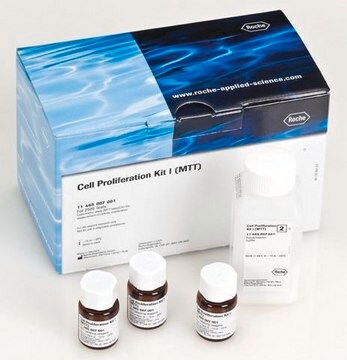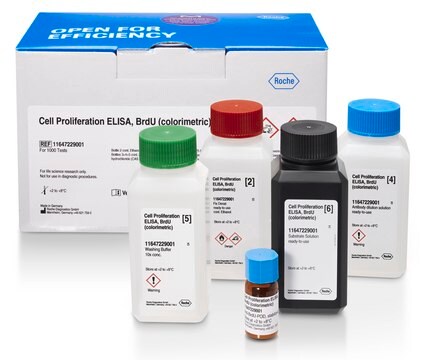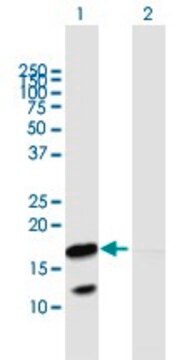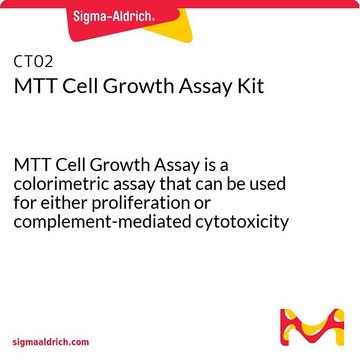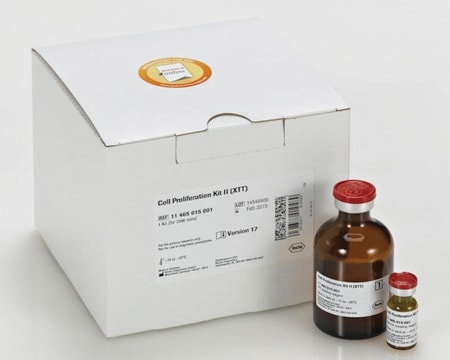おすすめの製品
交差性
mouse, rat, human
テクニック
ELISA: suitable
詳細
The Cell Proliferation Assay kit is used for fast and sensitive quantification of cell proliferation and viability. The assay is based on the cleavage of the tetrazolium salt WST-1 to formazan by cellular mitochondrial dehydrogenases. Expansion in the number of viable cells results in an increase in the overall activity of the mitochondrial dehydrogenases in the sample. The augmentation in enzyme activity leads to the increase in the amount of formazan dye formed. The formazan dye produced by viable cells can be quantified by a multiwell spectrophotometer (microplate reader) by measuring the absorbance of the dye solution at 440 nm. The assay can be used for the measurement of cell proliferation in response to growth factors, cytokines, mitogens and nutrients. It can also be used for the analysis of cytotoxic compounds like anticancer drugs and many other toxic agents and pharmaceutical compounds. This method is simple, requiring no washing, no harvesting and no solubilization steps, and it is faster and more sensitive than the MTT-based assay. The entire assay can be performed in one microplate.
アプリケーション
PROTOCOL:
1. Culture cells (0.1-5x104/well in a 96-well microplate in a final volume of 100 μL/well culture medium in the absence or presence of various amounts of factors tested.Note: For toxicity assays, use more cells to start with (e.g. 5x104 - 5x105 cells/well).
2. Incubate cells for 24-96 hours.
3. Add 10 μL/well WST-1/ECS solution to each well.Note: If the cells are cultured in a different volume of culture medium, increase or decrease the amount of WST-1/ECS solution accordingly.
4. Incubate the cells for 0.5 to 4 hours in standard culture conditions.Note: The appropriate incubation time depends on the individual cell type and cell concentration used. Therefore it is recommended that you determine the optimal incubation time for each experimental setup used.
5. Shake thoroughly for one minute on a shaker.
6. Measure the absorbance of the treated and untreated samples using a microplate reader at 420-480 nm depending on the filters available. The reference wavelength should be more than 600 nm. Note: Using the same amount of culture medium and WST-1/ECS solution in an empty well as a blank position for the microplate reader.
1. Culture cells (0.1-5x104/well in a 96-well microplate in a final volume of 100 μL/well culture medium in the absence or presence of various amounts of factors tested.Note: For toxicity assays, use more cells to start with (e.g. 5x104 - 5x105 cells/well).
2. Incubate cells for 24-96 hours.
3. Add 10 μL/well WST-1/ECS solution to each well.Note: If the cells are cultured in a different volume of culture medium, increase or decrease the amount of WST-1/ECS solution accordingly.
4. Incubate the cells for 0.5 to 4 hours in standard culture conditions.Note: The appropriate incubation time depends on the individual cell type and cell concentration used. Therefore it is recommended that you determine the optimal incubation time for each experimental setup used.
5. Shake thoroughly for one minute on a shaker.
6. Measure the absorbance of the treated and untreated samples using a microplate reader at 420-480 nm depending on the filters available. The reference wavelength should be more than 600 nm. Note: Using the same amount of culture medium and WST-1/ECS solution in an empty well as a blank position for the microplate reader.
構成
WST-1 Reagent (lyophilized 1 vial Electro Coupling Solution (ECS) 5 mL
保管および安定性
Store kit components at -20°C for up to 1 year from date of purchase. Protect from light. After reconstituting the WST-1 reagent aliquot (1 mL is sufficient for assay with one 96-well microplate) and maintain at -20°C for up to 3 months. REAGENT PREPARATION: Dissolve the lyophilized WST-1 reagent with 5 mL of the Electro Coupling Solution (ECS). It should be purple-red in color. If the solution is yellow in color the aliquot should be discarded.
免責事項
Unless otherwise stated in our catalog or other company documentation accompanying the product(s), our products are intended for research use only and are not to be used for any other purpose, which includes but is not limited to, unauthorized commercial uses, in vitro diagnostic uses, ex vivo or in vivo therapeutic uses or any type of consumption or application to humans or animals.
保管分類コード
10 - Combustible liquids
WGK
WGK 3
適用法令
試験研究用途を考慮した関連法令を主に挙げております。化学物質以外については、一部の情報のみ提供しています。 製品を安全かつ合法的に使用することは、使用者の義務です。最新情報により修正される場合があります。WEBの反映には時間を要することがあるため、適宜SDSをご参照ください。
毒物及び劇物取締法
キットコンポーネントの情報を参照してください
PRTR
キットコンポーネントの情報を参照してください
消防法
キットコンポーネントの情報を参照してください
労働安全衛生法名称等を表示すべき危険物及び有害物
キットコンポーネントの情報を参照してください
労働安全衛生法名称等を通知すべき危険物及び有害物
キットコンポーネントの情報を参照してください
カルタヘナ法
キットコンポーネントの情報を参照してください
Jan Code
キットコンポーネントの情報を参照してください
試験成績書(COA)
製品のロット番号・バッチ番号を入力して、試験成績書(COA) を検索できます。ロット番号・バッチ番号は、製品ラベルに「Lot」または「Batch」に続いて記載されています。
ライフサイエンス、有機合成、材料科学、クロマトグラフィー、分析など、あらゆる分野の研究に経験のあるメンバーがおります。.
製品に関するお問い合わせはこちら(テクニカルサービス)